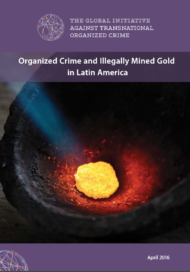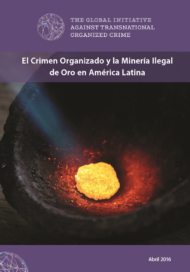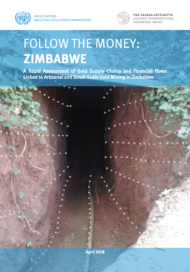Posted on 30 Mar 2016
Throughout history, man has venerated gold. Gold was the first of the three gifts of the Magi to Jesus. For much of the 19th and 20th centuries, the values of world currencies were fixed in terms of gold (the Gold Standard). Olympic athletes vie for gold medals and the best footballer in the world is awarded the Ballon d’Or. An extremely well behaved child is ‘as good as gold’ and a generous person has ‘a heart of gold’.
Extent of the nexus between organized crime and illegally mined gold
It is only natural to think positively about gold, just as it is equally natural to think negatively about drugs. But, as the Global Initiative proves in its latest research report: “Organised Crime and Illegally Mined Gold in Latin America”, illegally mined gold is now more important to organized crime in some countries of Latin America than narcotics:
- In Peru and Colombia – the largest cocaine producers in the world – the value of illegal gold exports now exceeds the value of cocaine exports.
- Illegal mining is the easiest and most profitable way to launder money in the history of Colombian drug trafficking.

In the first decade of the 21st century, two trends intersected: soaring gold prices greatly increased the profitability of gold mining, whilst the US led “War on Drugs”, notably in Colombia and Mexico (‘Plan Colombia’ and the ‘Mérida Initiative’), sharply reduced the profitability of drug trafficking from Latin America to the USA. As a result, there were considerable incentives for the criminal groups that control the drug trade to move into gold mining, and the fragmented nature of artisanal gold mining in Latin America greatly facilitated their entry. These groups were quick to realise that taking control of large swaths of land remote from government attention and dominating the enterprises that mined that land would enable them to generate larger profit margins with much lower risk.
Even though global gold prices have gradually decreased in recent years, organized criminal groups have continued to drive the expansion of illegal gold mining. The region is now unique in the high percentage of gold that is mined illegally; about 28% of gold mined in Peru, 30% of gold mined in Bolivia, 77% of gold mined in Ecuador, 80% of gold mined in Colombia and 80-90% of Venezuelan gold is produced illegally. Illegal gold mining employs hundreds of thousands of workers across Latin America, many of whom are extremely vulnerable to labour exploitation and human trafficking.
Devastating environmental impact and linkages to other forms of organised crime
Beyond the financial element, gold mining is one of the most destructive industries in the world and illegal mining in particular can be catastrophic for the environment as it ignores legal requirements and restrictions. It displaces communities, contaminates drinking water and destroys pristine environments. It pollutes water and land with mercury and cyanide, endangering the health of people and ecosystems:
- Colombia has the largest population of displaced persons in the world, of which 87% come from areas with a heavy presence of illegal mining.
- Artisanal gold miners dump more than 30 tons of mercury in rivers and lakes in the Amazon region every year, poisoning fish and causing brain damage to humans living as far as 400km downstream.
- There has been massive deforestation of the Amazon rainforest, the “lungs of the planet”.
- The human cost of the expansion of illegal mining is horrifying. Our research uncovered numerous instances of labour trafficking and exploitation, sex trafficking and child labour.
- In Sur de Bolívar, Colombia, 1,500 workers were employed at a mine owned by the wife of an ex-AUC leader and were not able to leave the area without being accompanied by the narco-paramilitary group operating in the area.
Critical Responses Gaps
Although there is an increased focus on laws and regulations to combat organized crime, reduce the use of conflict minerals, fight human trafficking, protect the environment and reduce corruption, there still appear to be gaps in regulation and enforcement.
Corporate guidance principles, whilst a welcome development, are limited due to their voluntary nature and do not result in due diligence across all levels of the supply chain.
Industry codes of conduct tend to focus on the large-scale mining sector whilst the problems we have highlighted belong more to the artisanal and small-scale sector. Certification schemes tend to be vague and implementation is often weak. There are too many private sector initiatives with major overlaps and gaps.
In 2015, Global Initiative Against Transnational Organized Crime carried out desk and field research in Latin America in order to investigate links between organized crime and illegal gold mining and to explore the manner in which the nexus between organized crime and illegal gold mining funds criminal and terrorist groups, facilitates money laundering and corruption, forcibly displaces local populations, speeds environmental destruction and creates situations of labour exploitation, labour trafficking, and sex trafficking. Desk research focused on Bolivia, Brazil, Colombia, Ecuador, Guyana, Mexico, Nicaragua, Peru and Venezuela. Field research was also conducted in Colombia and Peru. Field researchers visited illegal gold mining areas and interviewed local and international experts, mine workers and members of local populations affected by illegal gold mining.
The research findings amply demonstrate the many links between gold mined illegally and organized crime and give considerable detail on the actors involved, the manner in which they have infiltrated the gold production sectors, and how they launder not only the production from illegal mines but also drug moneys.
Recommendations
Global Initiative believes that it is critical to limit the involvement of organized crime in the illegal mining of gold and recommends urgently that:
- Export Countries simplify and better fund the formalization process by which informal miners may gain legal status, ensure that inspectors have sufficient resources and capacity to protect, remediate and rehabilitate victims of exploitation, and hold companies and criminal organizations involved in the extraction and export of illegally mined gold accountable;
- Import Countries oblige stakeholders and their subcontractors to comply with both international and domestic standards regarding human and labour rights and environmental standards, enforce legislation such as the ‘EU conflict mineral law’ and hold companies that import and sell illegally mined gold accountable;
- Corporations adhere to the UN Guiding Principles on Business and Human Rights and implement improved mechanisms to map out supply chains, responsibly source gold and ensure that gold is not produced illegally and/or under conditions that result in human or labour rights violations.
For more information, please contact the author, Livia Wagner, at livia.wagner@globalinitiative.net.





